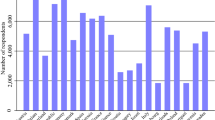Abstract
Using large nationally representative longitudinal data on changes in happiness and mortality and multivariate increment–decrement life tables, we assess length of quality life through cohort estimates of happy life expectancies. We examine population-based and status-based life expectancies in absolute term of years and relative term of proportions. We find that happy life expectancies exceed unhappy life expectancies in both absolute and relative terms for the overall population and population in each state of happiness at any given age. Being happy (as opposed to unhappy) at any age brings a longer life and more of the future life spent in happiness. We also examine social differentials in the estimates of happy life expectancy at each age by sex, race, and education. The educational gap in happy life expectancies is larger than the sex and race gaps. For the better educated, longer life consists of a longer happy life and shorter unhappy life in both years and proportions and regardless of happy or unhappy status at any given age.






Similar content being viewed by others
References
Coleman, J. S. (1981). Longitudinal data analysis. New York: Basic Books.
Crimmins, E. M., & Saito, Y. (2001). Trends in healthy life expectancy in the United States 1970–1990. Social Science and Medicine, 52, 1629–1641
Crimmins, E. M., Saito, Y., & Ingegneri, D. (1997). Trends in disability-free life expectancy in the united states, 1970–90. Population and Development Review, 23, 555–572.
Di Tella, R., MacCulloch, R. J., & Oswald, A. J. (2003). The macroeconomics of happiness. The Review of Economics and Statistics, 85, 809–827.
Easterlin, R. A. (2001). Life cycle welfare: Trends and differences. Journal of Happiness Studies, 2, 1–12.
Fries, J. F. (2003). Measuring and monitoring success in compressing morbidity. Annals of Internal Medicine, 139, 455–459.
George, L. K. (2006). Perceived quality of life. In R. H. Binstock & L. K. George (Eds.), Handbook of aging and the social sciences (6th ed., pp. 320–336). San Diego, CA: Elsevier.
Katz, S., Branch, L. G., Branson, M. H., Papsidero, J. A., Beck, J. C., & Creer, D. S. (1983). Active life expectancy. New England Journal of Medicine, 309, 1218–1224.
Land, K. C., Guralnik, J. M., & Blazer, D. G. (1994). Estimating increment–decrement life tables with multiple covariates from panel data: The case of active life expectancy. Demography, 31, 297–319.
Manton, K. G., & Land, K. C. (2000). Active life expectancy estimates for the U.S. elderly population: A multidimensional continuous-mixture model of functional change applied to completed cohorts, 1982–1996. Demography, 37, 253–265.
Palloni, A. (2001). Increment–decrement life tables. In S. H. Preston, P. Heuveline, & M. Guillot (Eds.), Demography: Measuring and modeling population processes (pp. 256–272). Oxford: Blackwell.
Robine, J.-M., & Ritchie, K. (1991). Healthy life expectancy: Evaluation of global indicator of change in population health. British Medical Journal, 302, 457–460.
Rodgers, A. (1992). Heterogeneity and selection in multistate population analysis. Demography, 29, 31–38.
Sanders, B. S. (1964). Measuring community health levels. American Journal of Public Health, 54, 1063–1070.
Schoen, R. (1988). Modeling multigroup populations. New York: Plenum.
Schoen, R., & Land, K. C. (1979). A general algorithm for estimating a Markov-generated increment–decrement life table, with applications to marital status patterns. Journal of the American Statistical Association, 74, 761–776.
Sullivan, D. F. (1971). A single index of mortality and morbidity. HSMHA Health Reports, 86, 347–354.
Sweet, J. A., & Bumpass, L. L. (1996). The national survey of families and households—waves 1 and 2: Data description and documentation. http://www.ssc.wisc.edu/nsfh/home.htm.
Veenhoven, R. (1992). Happiness in nations. World database of happiness, distributional findings in nations. Retrieved December 4, 2006, from http://www.worlddatabaseofhappiness.eur.nl/.
Veenhoven, R. (1996). Happy life expectancy: A comparative measure of quality of life in nations. Social Indicators Research, 39, 1–58.
Veenhoven, R. (1997). Advances in understanding happiness. Revue Québécoise de Psychologie, 18, 29–74.
Winship, C., & Radbill, L. (1994). Sample weights and regression analysis. Sociological Methods and Research, 23, 230–257.
Yang, Y. (2008a). Long and happy living: Trends and patterns of happy life expectancy in the U.S., 1970–2000. Social Science Research, 37, 1235–1252.
Yang, Y. (2008b). Social inequalities in happiness in the U.S. 1972–2004: An age-period-cohort analysis. American Sociological Review, 73, 204–226.
Acknowledgement
This research is supported by National Institute on Aging grant no. 1R03AG030000-01.
Author information
Authors and Affiliations
Corresponding author
Rights and permissions
About this article
Cite this article
Yang, Y., Waliji, M. Increment–Decrement Life Table Estimates of Happy Life Expectancy for the U.S. Population. Popul Res Policy Rev 29, 775–795 (2010). https://doi.org/10.1007/s11113-009-9162-5
Received:
Accepted:
Published:
Issue Date:
DOI: https://doi.org/10.1007/s11113-009-9162-5




